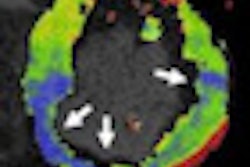These days, virtual colonoscopy is more likely than ever to be reimbursed. But insurers are still more likely to pay for the procedure as a diagnostic tool after failed optical colonoscopy, or for examining frail and at-risk patients, than for screening asymptomatic adults, according to Dr. Abraham Dachman.
Dachman, from the University of Chicago Medical Center, spoke on the topic last week at the Society of Gastrointestinal Radiologists (SGR) Abdominal Radiology Course 2011 in Carlsbad, CA. He said that acceptance of VC (also known as CT colonography or CTC) as a legitimate screening tool is growing and is increasingly accepted by payors as a follow-up to showing symptoms or a failed optical colonoscopy.
"It's minimally invasive, doesn't require sedation, and patients prefer it because of the milder prep with [barium] tagging of stool [rather than requiring a clean colon]," he said. "Why not use CTC to screen and fill the colonoscopy schedules with follow-up patients who must undergo an invasive procedure?"
Dachman punctuated his talk with a two-minute video he made with his 12-year-old daughter Eliana that promotes screening acceptance -- and ends with a character willing to undergo the virtual procedure saying, "Yay. Yay. Yay."
The support for virtual colonoscopy as a screening tool is mixed; the American Cancer Society and Blue Cross/Blue Shield in some states favor it, while the U.S. Preventive Services Task Force and Medicare oppose it.
"Screening means the patient is asymptomatic," he said. "If there's blood, pain, a change in bowel habits, weight loss -- anything in those accepted symptoms -- then the procedure is diagnostic," Dachman said. "Just because there's a failed optical doesn't upgrade the CTC to diagnostic."
Medicare does pay for a diagnostic CTC after a failed optical procedure; in fact, Medicare's approval of payment for colonoscopies is improving, Dachman said. In 2005, Medicare denied 70% of the 3,663 requests, while in 2008, Medicare denied 48% of the 10,800 reimbursement requests, he noted.
Virtual colonoscopy has been around since 1994, and the procedure was eventually given its own billing codes in July 2004. Last year, a month before President Barack Obama underwent a virtual colonoscopy, the U.S. Centers for Medicare and Medicaid Services upped the procedure to category II from category III, where coverage was routinely denied.
The American College of Radiology (ACR) subcommittee on CTC has been lobbying in Washington, DC, and working with state groups to get the Medicare ruling reviewed. The subcommittee sponsored a webinar for managed care executives in September to promote the use of CTC for screening.
At present, Dachman found the following:
- Many private insurers, including Cigna, United Healthcare, and Anthem Blue Cross/Blue Shield, cover both screening and diagnostic CTC.
- 46 states, Puerto Rico, the Virgin Islands, and Washington, DC, cover diagnostic CTC in some instances.
- 27 states and Washington, DC, cover diagnostic CTC when optical colonoscopy is contraindicated.
- 28 states, Puerto Rico, and Washington, DC, cover diagnostic CTC after a failed optical colonoscopy.
- 19 states restrict failed coverage to occluding cancers.
- Four states do not yet have coverage.
- 22 states have laws that may require them to follow American Cancer Society recommendations for cancer screening.
Dachman began using virtual colonoscopy in 1998 and officially made it part of his practice in 2000, he said. Virtual colonoscopy is already used for frail or elderly patients, and Dachman said he insists on CTC for kidney transplant patients and any patient with just one functioning kidney.
Arguments against using CTC for screening include that patients need to be prepped anyway and may need follow-up they can't immediately receive. In addition, extracolonic findings add to the cost and worry, whereas there are fewer worrisome finds with a regular colonoscopy. Needless exposure to radiation has also been raised as an issue.
"Insurers ask for proof of training and policy compliance," Dachman said. Reimbursement rates vary widely, between $250 and $900, with California reimbursement at the lower end at $298, he said. That rate barely covers supplies, Dachman said.
Access to CT for colonoscopy is still limited, particularly for smaller hospitals. Although an average of 16.8% of all hospitals have the technology, a study published this year by Megan McHugh, PhD, of Northwestern University found that 36.5% of large hospitals have the technology.
Dachman, like the ACR, argues that traditional colonoscopy, even with universal polypectomy, is far riskier than CTC with colonoscopy as a follow-up. A 2007 study by Dr. David Kim from the University of Wisconsin that compared the effectiveness of CTC versus traditional colonoscopy found that CTC identified advanced neoplasia in 3.2% of the 3,168 patients, while traditional colonoscopy found it in 3.4%.
But CTC led to 561 polypectomies, a referral rate of 7.9%, whereas optical colonoscopy resulted in the removal of 2,434 polyps, the majority of which were benign.
"Using polypectomy is inefficient since we know the vast majority do not become cancer," he said. "It's an easy answer, but not a good one. The perforation rate is one in a thousand. A third of the perforations require resection and 7% of those patients die. That means a healthy person dies because they sought screening."



















